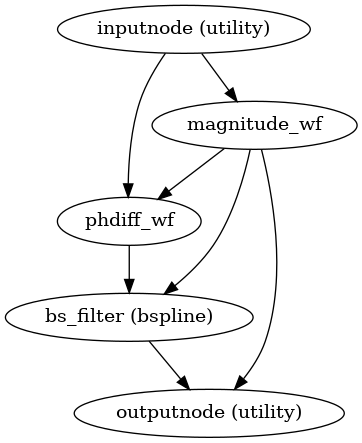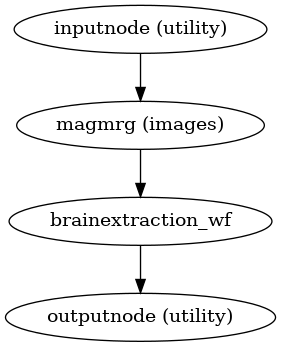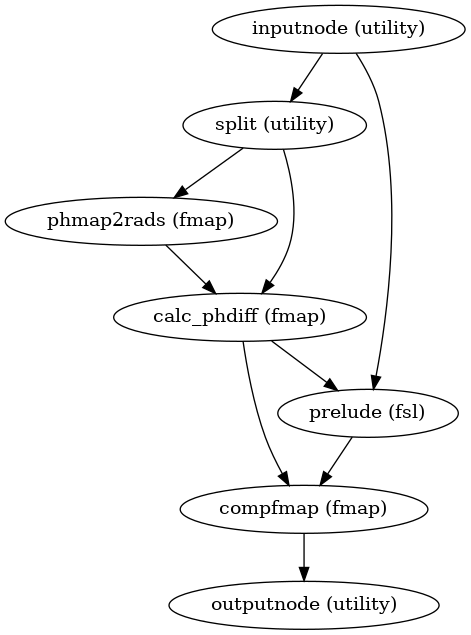sdcflows.workflows.fit.fieldmap module¶
Processing phase-difference and directly measured \(B_0\) maps.
Theory¶
The displacement suffered by every voxel along the phase-encoding (PE) direction can be derived from Eq. (2) of [Hutton2002]:
where \(\Delta_\text{PE} (i, j, k)\) is the voxel-shift map (VSM) along the PE direction, \(\gamma\) is the gyromagnetic ratio of the H proton in Hz/T (\(\gamma = 42.576 \cdot 10^6 \, \text{Hz} \cdot \text{T}^\text{-1}\)), \(\Delta B_0 (i, j, k)\) is the fieldmap variation in T (Tesla), and \(T_\text{ro}\) is the readout time of one slice of the EPI dataset we want to correct for distortions.
Let \(V\) represent the «fieldmap in Hz» (or equivalently, «voxel-shift-velocity map» as Hz are equivalent to voxels/s), with \(V(i,j,k) = \gamma \cdot \Delta B_0 (i, j, k)\), then, introducing the voxel zoom along the phase-encoding direction, \(s_\text{PE}\), we obtain the nonzero component of the associated displacements field \(\Delta D_\text{PE} (i, j, k)\) that unwarps the target EPI dataset:
Direct B0 mapping sequences¶
Some MR schemes such as SEI can directly reconstruct an estimate of the fieldmap in Hz, \(V(i,j,k)\). These fieldmaps are described with more detail here.
This corresponds to this section of the BIDS specification.
Phase-difference B0 estimation¶
The fieldmap variation in T, \(\Delta B_0 (i, j, k)\), that is necessary to obtain \(\Delta_\text{PE} (i, j, k)\) in Eq. \(\eqref{eq:fieldmap-1}\) can be calculated from two subsequient GRE echoes, via eq. (1) of [Hutton2002]:
where \(\Delta \Theta (i, j, k)\) is the phase-difference map in radians, and \(\Delta\text{TE}\) is the elapsed time between the two GRE echoes.
For simplicity, the «voxel-shift-velocity map» \(V(i,j,k)\), which we can introduce in Eq. \(\eqref{eq:fieldmap-2}\) to directly obtain the displacements field, can be obtained as:
This calculation is further complicated by the fact that \(\Theta_i\) (and therefore, \(\Delta \Theta\)) are clipped (or wrapped) within the range \([0 \dotsb 2\pi )\). It is necessary to find the integer number of offsets that make a region continuously smooth with its neighbors (phase-unwrapping, [Jenkinson2003]).
This corresponds to this section of the BIDS specification.
Some scanners produce one phasediff map, where the drift between the two echos has
already been calculated (see the corresponding section of BIDS).
References
- Hutton2002(1,2)
Hutton et al., Image Distortion Correction in fMRI: A Quantitative Evaluation, NeuroImage 16(1):217-240, 2002. doi:10.1006/nimg.2001.1054.
- Jenkinson2003(1,2)
Jenkinson, M. (2003) Fast, automated, N-dimensional phase-unwrapping algorithm. MRM 49(1):193-197. doi:10.1002/mrm.10354.
-
sdcflows.workflows.fit.fieldmap.init_fmap_wf(omp_nthreads=1, sloppy=False, debug=False, mode='phasediff', name='fmap_wf')[source]¶ Estimate the fieldmap based on a field-mapping MRI acquisition.
Estimates the fieldmap using either one phase-difference map or image and one or more magnitude images corresponding to two or more GRE acquisitions.
When we have a sequence that directly measures the fieldmap, we just need to mask it (using the corresponding magnitude image) to remove the noise in the surrounding air region, and ensure that units are Hz.
- Workflow Graph

(Source code, png, svg, pdf)
- Parameters
- Inputs
- Outputs
fmap (
str) – Path to the estimated fieldmap.fmap_ref (
str) – Path to a preprocessed magnitude image reference.fmap_coeff (
strorlistofstr) – The path(s) of the B-Spline coefficients supporting the fieldmap.fmap_mask (
str) – Path to a binary brain mask corresponding to thefmapandfmap_refpair.method (
str) – Short description of the estimation method that was run.
-
sdcflows.workflows.fit.fieldmap.init_magnitude_wf(omp_nthreads, name='magnitude_wf')[source]¶ Prepare the magnitude part of GRE fieldmaps.
Average (if not done already) the magnitude part of the GRE images, run N4 to correct for B1 field nonuniformity, and skull-strip the preprocessed magnitude.
- Workflow Graph

(Source code, png, svg, pdf)
- Parameters
- Inputs
magnitude (
os.PathLike) – Path to the corresponding magnitude path(s).- Outputs
fmap_ref (
os.PathLike) – Path to the fieldmap reference calculated in this workflow.fmap_mask (
os.PathLike) – Path to a binary brain mask corresponding to the reference above.
-
sdcflows.workflows.fit.fieldmap.init_phdiff_wf(omp_nthreads, debug=False, name='phdiff_wf')[source]¶ Generate a \(B_0\) field from consecutive-phases and phase-difference maps.
This workflow preprocess phase-difference maps (or generates the phase-difference map should two
phase1/phase2be provided at the input), and generates an image equivalent to BIDS’sfieldmapthat can be processed with the general fieldmap workflow.Besides phase2 - phase1 subtraction, the core of this particular workflow relies in the phase-unwrapping with FSL PRELUDE [Jenkinson2003]. FSL PRELUDE takes wrapped maps in the range 0 to 6.28, as per the user guide.
For the phase-difference maps, recentering back to \([-\pi \dotsb \pi )\) is necessary. After some massaging and with the scaling of the echo separation factor \(\Delta \text{TE}\), the phase-difference maps are converted into an actual \(B_0\) map in Hz units.
- Workflow Graph

(Source code, png, svg, pdf)
- Parameters
- Inputs
magnitude (
os.PathLike) – A reference magnitude image preprocessed elsewhere.phase (
listoftupleof (os.PathLike,dict)) – List containing one GRE phase-difference map with its corresponding metadata (requiresEchoTime1andEchoTime2), or the phase maps for the two subsequent echoes, with their metadata (requiresEchoTime).mask (
os.PathLike) – A brain mask calculated from the magnitude image.
- Outputs
fieldmap (
os.PathLike) – The estimated fieldmap in Hz.